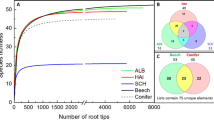Abstract
Spatial patterns of ectomycorrhizal fungi, ectomycorrhizal plants, and non-ectomycorrhizal plants were investigated in a natural subtropical forest using second-order analysis. The results of spatial pattern analysis showed that the degree of clumping of woody plants and ectomycorrhizal sporocarps were correlated. There was a significantly positive correlation of relative aggregation indices between ectomycorrhizal fungi and both non-ectomycorrhizal trees and ectomycorrhizal saplings. Correlations between percentage of ectomycorrhizal trees and sporocarp occurrence of ectomycorrhizal fungi and between diversities of woody plants and ectomycorrhizal fungi were distance-dependent or scale-related. A significantly high percentage of ectomycorrhizal trees was found only at relatively short distance from ectomycorrhizal fungal sporocarps, and significantly positive correlation of the diversity between woody plants and ectomycorrhizal fungi was found only at relative long distance, which implied that ectomycorrhizal sporocarps prefer ectomycorrhizal-tree-dominant micro-sites at near distances and at relatively large scales, diverse ectomycorrhizal sporocarps could be found in woodlands with high diversity of woody plants. Important factors affecting the spatial distribution, occurrence, and diversity of ectomycorrhizal fungi include spatial pattern of ectomycorrhizal plants and non-ectomycorrhizal plants, percentage of ectomycorrhizal plants, and plant diversity in a natural forest.







Similar content being viewed by others
References
Andersen M (1992) Spatial analysis of two-species interactions. Oecologia 91:134–140
Dahlberg A (2001) Community ecology of ectomycorrhizal fungi: an advancing interdisciplinary field. New Phytol 150:555–562
Dale MRT (1999) Spatial pattern analysis in plant ecology. Cambridge University Press, Cambridge, UK, pp 206–241
Dale MRT, Dixon P, Fortin MJ, Legendre P, Myers DE, Rosenberg MS (2002) Conceptual and mathematical relationships among methods for spatial analysis. Ecography 25:558–577
Erland S, Taylor AES (2002) Diversity of ecto-mycorrhizal fungal communities in relation to the abiotic environment. In: van der Heijden MGA, Sanders IR (eds) Mycorrhizal ecology. Springer, Berlin Heidelberg New York, pp 163–200
Ford ED, Mason PA, Pelham J (1980) Spatial patterns of sporophore distribution around a young birch tree in three successive years. Trans Br Mycol Soc 75:287–296
Getis A, Franklin J (1987) Second-order neighborhood analysis of mapped point patterns. Ecology 68:473–477
Gong MQ, Chen YL, Zhong CL (1997) Mycorrhizal research and application. China Forestry Publishing House, Beijing, China, pp 35–60
Goreaud F, Pélissier R (1999) On explicit formulas of edge effect correction for Ripley’s K-function. J Veg Sci 10:433–438
Haase P (1995) Spatial pattern analysis in ecology based on Ripley’s K-function: introduction and methods of edge correction. J Veg Sci 6:575–582
Last FT, Mason PA, Ingleby K, Fleming LV (1984) Succession of fruitbodies of sheathing mycorrhizal fungi associated with Betula pedula. For Ecol Manag 9:229–234
Last FT, Natarajan K, Mohan V, Mason PA (1992) Sequences of sheathing (ecto-) mycorrhizal fungi associated with man-made forests, temperate and tropical. In: Read DJ, Lewis DH, Fitter AH, Alexander IJ (eds) Mycorrhizas in ecosystems. CAB International, Wallingford, UK, pp 214–219
Liang Y, Guo LD, Ma KP (2004a) Spatial pattern of the most common late-stage ectomycorrhizal fungi in a subtropical forest in Dujiangyan, southwest of China. Acta Bot Sin 46:29–34
Liang Y, Guo LD, Ma KP (2004b) Genetic structure of a population of the ectomycorrhizal fungus Russula vinosa in subtropical woodlands in southwest China. Mycorrhiza 14:235–240
Molina R, Massicotte H, Trappe JM (1992) Specificity phenomena in mycorrhizal symbioses: community–ecological consequences and practical implications. In: Allen MF (ed) Mycorrhizal functioning: an integrative plant–fungal process. Chapman & Hall, New York, pp 357–423
Nillson LO, Wallander H (2003) Production of external mycelium by ectomycorrhizal fungi in a Norway spruce forest was reduced in response to nitrogen fertilization. New Phytol 158:409–416
Pielou EC (1985) Mathematical ecology, 2nd edn. Wiley, NY
Read DJ (1991) Mycorrhizas in ecosystems. Experientia 47:376–391
Read DJ (1997) Mycorrhizal fungi—the ties that bind. Nature 388:517–518
Ripley BD (1976) The second-order analysis of stationary processes. J Appl Probab 13:255–266
Simard SW, Perry DA, Jones MD, Myrold DD, Durall DM, Molina R (1997) Net transfer of carbon between ectomycorrhizal tree species in the field. Nature 388:579–582
Simard SW, Jones MD, Durall DM (2002) Carbon and nutrient fluxes within and between mycorrhizal plants. In: van der Heijden MGA, Sanders IR (eds) Mycorrhizal ecology. Springer, Berlin Heidelberg New York, pp 34–74
Smith JE, McKay D, Brenner G, McIver J, Spatafora JW (2005) Early impacts of forest restoration treatments on the ectomycorrhizal fungal community and fine root biomass in a mixed conifer forest. J Appl Ecol 42:526–535
Tedersoo L, Koljalg U, Hallenberg N, Larsson KH (2003) Fine scale distribution of ectomycorrhizal fungi and roots across substrate layers including coarse woody debris in a mixed forest. New Phytol 159:153–165
Thioulouse J, Chessel D, Dolédec S, Olivier JM (1997) ADE-4: a multivariate analysis and graphical display software. Stat Comput 7:75–83
Toide R, Xu B, Sharda J, Lekberg Y, Ostiguy N (2005) Evidence of species interactions within an ectomycorrhizal fungal community. New Phytol 165:305–316
Visser S (1995) Ectomycorrhizal fungal succession in jack pine stands following wildfire. New Phytol 129:389–401
Acknowledgment
This work was supported by National Natural Science Foundation of China Grants (30370006, 30470006, 30230020, 30499340) and a State Key Basic Research and Development Plan of China Grant (G2000046802). We are grateful to the West China Subalpine Botanical Garden, the Chinese Academy of Sciences for providing climate data for the study site and Dr. X.-M. Gao, Mr. C.-W. Liu, and Dr. P. Zhuang for their assistance in plant identification.
Author information
Authors and Affiliations
Corresponding authors
Rights and permissions
About this article
Cite this article
Liang, Y., Guo, LD., Du, XJ. et al. Spatial structure and diversity of woody plants and ectomycorrhizal fungus sporocarps in a natural subtropical forest. Mycorrhiza 17, 271–278 (2007). https://doi.org/10.1007/s00572-006-0096-z
Received:
Accepted:
Published:
Issue Date:
DOI: https://doi.org/10.1007/s00572-006-0096-z




